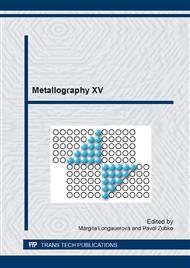p.3
p.8
p.16
p.23
p.31
p.41
p.45
p.51
Investigations on Microstructure Effect of Changing Fluid Flow Characteristic in High Pressure Die Casting
Abstract:
The flow and filling characteristics during injection of liquid aluminum in high pressure die casting is of significant importance for the product quality. As shown in [ the planar jet of liquid aluminum can be triggered by the design of the gating geometry. Depending on the inlet velocity and the gating design the liquid jet will disintegrate at the jet surface by drop formation and the free jet is dominated by atomization at the gating or by wavy disintegration at low flow velocities. Metallography of samples cast utilizing different nozzle designs are discussed with respect to casting inhomogeneities and microstructural changes respectively. These results are compared to numerical studies on the die filling flow characteristics as well as experimentally water modeling approaches.
Info:
Periodical:
Pages:
8-15
Citation:
Online since:
April 2014
Price:
Сopyright:
© 2014 Trans Tech Publications Ltd. All Rights Reserved
Share:
Citation:


